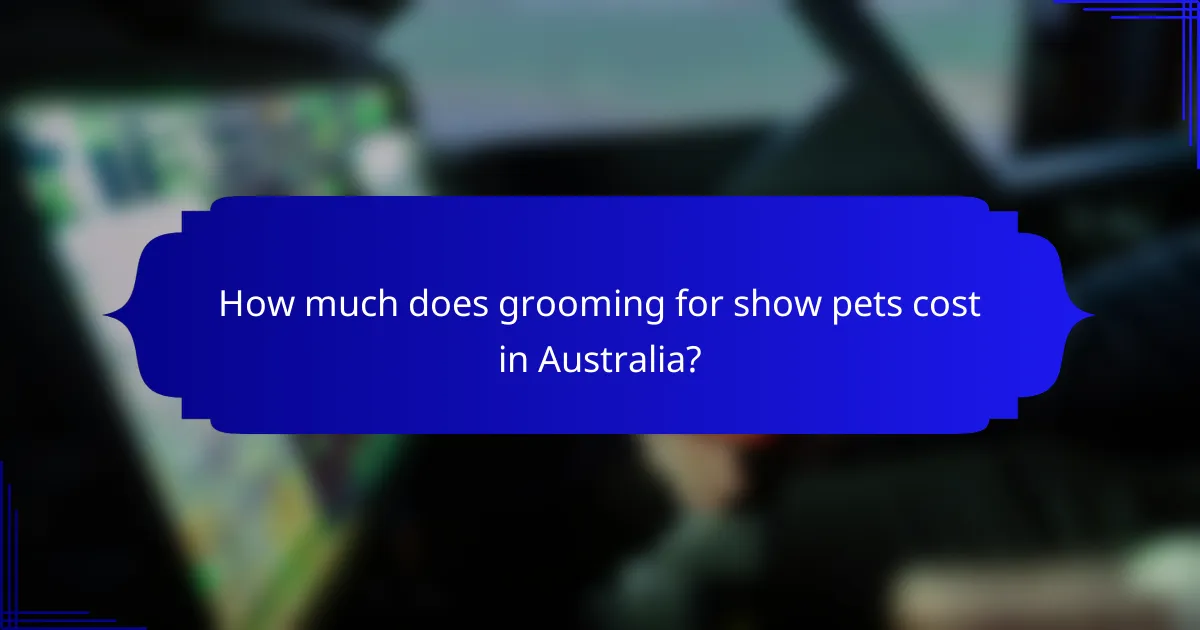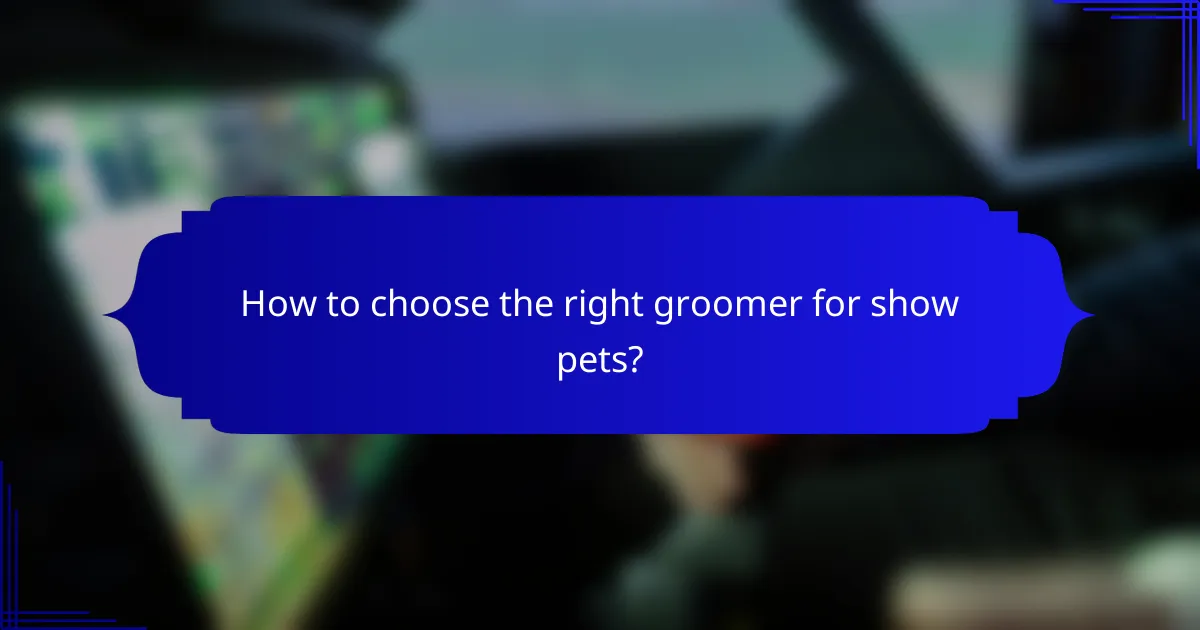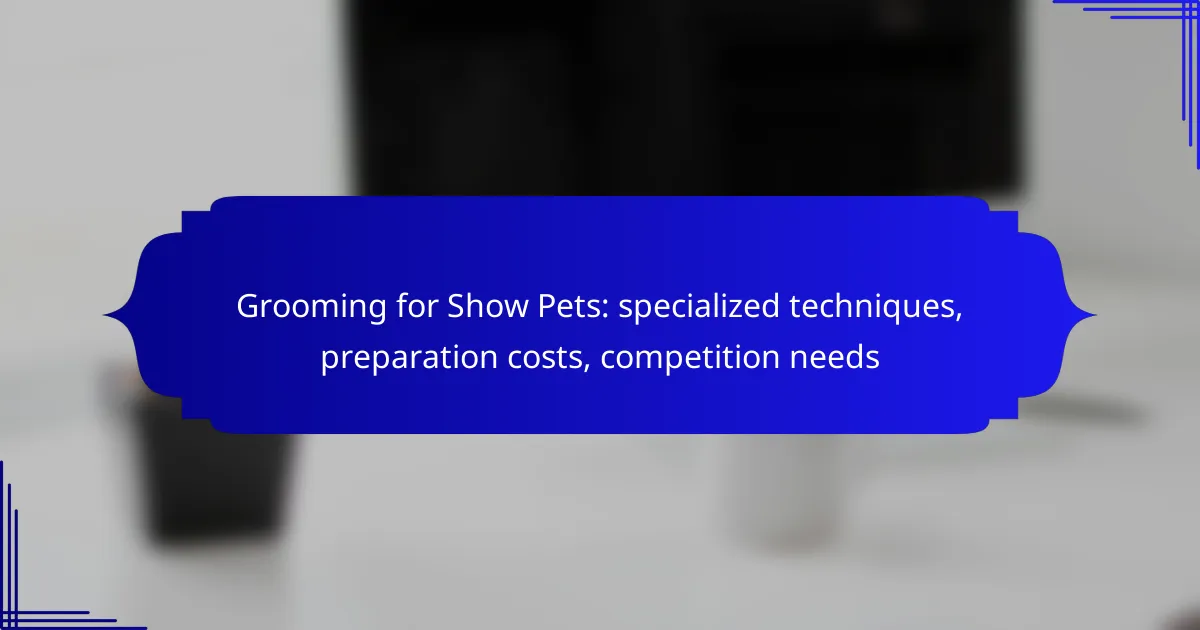Grooming for show pets involves specialized techniques designed to enhance each breed’s natural appearance and meet competition standards. This process can be costly, with expenses varying based on the pet type and grooming complexity, necessitating a significant investment in both grooming sessions and specialized tools. Adhering to specific grooming requirements is essential for success in competitions, as judges closely evaluate the cleanliness and presentation of each pet.

What specialized grooming techniques are essential for show pets in Australia?
Specialized grooming techniques for show pets in Australia focus on enhancing the breed’s natural appearance and ensuring they meet competition standards. Essential methods include hand stripping, scissoring, coat conditioning, ear cleaning, nail trimming, and teeth brushing, all tailored to specific breeds and their unique requirements.
Hand stripping for terriers
Hand stripping is a vital technique for grooming terriers, as it maintains the harsh texture of their coat. This method involves plucking out dead hair by hand, which helps promote healthy regrowth and preserves the breed’s characteristic look.
When hand stripping, it’s important to work in sections and be gentle to avoid discomfort. Regular grooming sessions, ideally every few weeks, can help keep the coat in top condition and ready for competition.
Scissoring techniques for poodles
Scissoring is essential for poodles to achieve their signature style and shape. This technique involves using scissors to create clean lines and defined shapes, particularly around the face, legs, and body.
For show preparation, it’s recommended to practice scissoring techniques regularly and consider the specific cut required for the competition. A well-groomed poodle should have a balanced appearance with a fluffy coat that showcases its elegance.
Coat conditioning for long-haired breeds
Coat conditioning is crucial for long-haired breeds, as it helps prevent tangles and maintains a healthy shine. Using high-quality conditioners and detanglers can make a significant difference in the coat’s texture and overall appearance.
Regular brushing, combined with conditioning treatments, should be part of the grooming routine. Aim for at least once a week for maintenance, increasing frequency before competitions to ensure the coat looks its best.
Ear cleaning and nail trimming
Ear cleaning and nail trimming are essential for overall pet hygiene and presentation. Clean ears help prevent infections, while properly trimmed nails prevent discomfort and ensure the pet stands correctly in the show ring.
For ear cleaning, use a vet-recommended solution and cotton balls, cleaning gently to avoid injury. Nail trimming should be done every few weeks, ensuring they are short enough to prevent snagging but not so short that they bleed.
Teeth brushing for show readiness
Teeth brushing is an important aspect of grooming for show pets, as a clean mouth contributes to overall health and appearance. Regular brushing helps prevent dental issues and keeps the pet’s breath fresh.
Use a toothbrush and toothpaste specifically designed for pets, brushing at least two to three times a week. This routine not only enhances the pet’s smile but also shows judges that the owner is attentive to every detail of their pet’s care.

How much does grooming for show pets cost in Australia?
Grooming for show pets in Australia can range from moderate to high costs, depending on the type of pet, the complexity of the grooming required, and the frequency of sessions. On average, pet owners should expect to invest significantly in both grooming sessions and specialized tools to ensure their pets meet competition standards.
Average grooming session prices
The cost of grooming sessions for show pets typically varies between AUD 50 to AUD 150 per visit. Factors influencing these prices include the breed of the pet, the specific services required, and the experience level of the groomer. For example, breeds with intricate grooming needs, like Poodles or Afghan Hounds, may incur higher fees due to the time and skill involved.
Regular grooming is essential for show pets, and many owners opt for bi-weekly or monthly sessions to maintain their pet’s appearance. This can lead to annual grooming costs ranging from AUD 1,200 to AUD 3,600, depending on the frequency and type of services chosen.
Cost of specialized grooming tools
Investing in specialized grooming tools is crucial for preparing show pets. Basic grooming kits can start at around AUD 100, while high-quality, professional-grade tools may cost several hundred dollars. Essential items include clippers, brushes, combs, and scissors tailored for specific breeds.
Additionally, products such as shampoos, conditioners, and styling sprays designed for show pets can add to the overall cost. Budgeting around AUD 200 to AUD 500 for grooming supplies annually is a reasonable estimate for serious competitors.
Budgeting for competition preparation
Preparing a show pet for competition involves more than just grooming; it includes training, health checks, and sometimes travel expenses. Owners should set aside a budget that encompasses all these aspects, which can easily reach thousands of dollars, especially for high-stakes competitions.
A practical approach is to create a detailed budget that includes grooming costs, training fees, veterinary care, and any travel or accommodation expenses. This comprehensive planning ensures that all necessary preparations are accounted for, helping to avoid unexpected financial strains as competition dates approach.

What are the competition grooming requirements for show pets?
Competition grooming requirements for show pets vary by breed and event but generally include specific standards for coat condition, cleanliness, and presentation. Adhering to these standards is crucial for success in competitions, as judges evaluate pets based on their grooming and overall appearance.
Breed-specific grooming standards
Each breed has unique grooming standards that must be met for competition. For example, breeds like Poodles require extensive grooming to maintain their distinctive coat styles, while short-haired breeds may need less frequent grooming but still require regular bathing and brushing. Familiarizing yourself with the specific requirements of your pet’s breed is essential for effective preparation.
Consult breed clubs or official guidelines to understand the grooming techniques and tools necessary for your pet. This may include specific clippers, scissors, or brushes tailored to the breed’s coat type.
Grooming timelines before competitions
Establishing a grooming timeline is critical to ensure your pet is in top condition for competition day. Typically, a thorough grooming session should occur one to two days before the event, allowing the coat to settle and look its best. Regular grooming sessions leading up to the competition, spaced out over several weeks, help maintain coat health and prevent matting.
Consider scheduling a final touch-up on the day of the competition to address any last-minute issues. Keeping a checklist of grooming tasks can help ensure nothing is overlooked as the event approaches.
Health checks and certifications
Health checks are a vital part of preparing show pets for competition. Many events require proof of vaccinations and health certifications to ensure the safety of all animals involved. Regular veterinary visits can help identify any underlying health issues that may affect your pet’s performance.
In some cases, specific health certifications may be mandated by competition organizers. It’s essential to verify these requirements well in advance to avoid any last-minute complications that could prevent your pet from participating.

What are the prerequisites for grooming show pets?
Grooming show pets requires specific skills, knowledge, and tools to meet competition standards. Groomers must understand breed-specific grooming techniques, maintain a high level of hygiene, and prepare pets for presentation.
Training programs for groomers
Training programs for groomers often include hands-on experience and theoretical knowledge about different breeds and grooming techniques. Many programs are available through vocational schools, online courses, or specialized grooming academies, typically lasting from a few weeks to several months.
Certification from recognized organizations can enhance a groomer’s credentials and improve job prospects. Look for programs that offer practical training, as this experience is crucial for mastering grooming skills.
Essential grooming supplies
Essential grooming supplies for show pets include high-quality clippers, scissors, brushes, and combs tailored to specific coat types. Additionally, grooming tables, drying equipment, and cleaning products are necessary to maintain a professional grooming environment.
Investing in quality tools can significantly affect the grooming process and the final appearance of the pet. Groomers should consider having a variety of tools to accommodate different breeds and grooming styles, ensuring they are prepared for any competition requirements.

How to choose the right groomer for show pets?
Choosing the right groomer for show pets involves finding someone with specialized experience and a proven track record in preparing animals for competition. Look for groomers who understand breed standards and can enhance your pet’s appearance while ensuring their comfort.
Evaluating groomer experience with show pets
When assessing a groomer’s experience with show pets, prioritize those who have worked specifically with your breed. Experienced groomers should be familiar with the unique grooming techniques required to meet breed standards, such as specific cuts or styles.
Ask potential groomers about their past competition successes and the types of pets they have groomed. A groomer who has prepared multiple pets for shows will likely have a better understanding of the nuances involved in presenting animals effectively.
Checking references and reviews
Before selecting a groomer, check their references and online reviews. Look for testimonials from clients who have successfully shown their pets after using the groomer’s services. Positive feedback can indicate the groomer’s reliability and skill.
Consider visiting local pet shows to observe the groomer’s work firsthand. Engaging with other pet owners can provide insights into their experiences and recommendations, helping you make a more informed decision.
